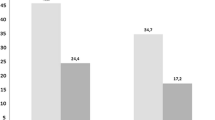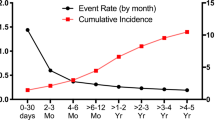Abstract
Venous thromboembolism (VTE) is common and has a high impact on morbidity, mortality, and costs of care. Although most of the patients with VTE are aged ≥65 years, there is little data about the medical outcomes in the elderly with VTE. The Swiss Cohort of Elderly Patients with VTE (SWITCO65+) is a prospective multicenter cohort study of in- and outpatients aged ≥65 years with acute VTE from all five Swiss university and four high-volume non-university hospitals. The goal is to examine which clinical and biological factors and processes of care drive short- and long-term medical outcomes, health-related quality of life, and medical resource utilization in elderly patients with acute VTE. The cohort also includes a large biobank with biological material from each participant. From September 2009 to March 2012, 1,863 elderly patients with VTE were screened and 1003 (53.8 %) were enrolled in the cohort. Overall, 51.7 % of patients were aged ≥75 years and 52.7 % were men. By October 16, 2012, after an average follow-up time of 512 days, 799 (79.7 %) patients were still actively participating. SWITCO65+ is a unique opportunity to study short- and long-term outcomes in elderly patients with VTE. The Steering Committee encourages national and international collaborative research projects related to SWITCO65+, including sharing anonymized data and biological samples.

Similar content being viewed by others
References
Rosendaal FR, Vanhv A, Doggen CJ (2007) Venous thrombosis in the elderly. J Thromb Haemost 5(Suppl 1):310–317
Cushman M, Tsai AW, White RH, Heckbert SR, Rosamond WD, Enright P et al (2004) Deep vein thrombosis and pulmonary embolism in two cohorts: the longitudinal investigation of thromboembolism etiology. Am J Med 117:19–25
Kniffin WD Jr, Baron JA, Barrett J, Birkmeyer JD, Anderson FA Jr (1994) The epidemiology of diagnosed pulmonary embolism and deep venous thrombosis in the elderly. Arch Intern Med 154:861–866
Naess IA, Christiansen SC, Romundstad P, Cannegieter SC, Rosendaal FR, Hammerstrom J (2007) Incidence and mortality of venous thrombosis: a population-based study. J Thromb Haemost 5:692–699
Oger E (2000) Incidence of venous thromboembolism: a community-based study in Western France. EPI-GETBP Study Group. Groupe d’Etude de la Thrombose de Bretagne Occidentale. Thromb Haemost 83:657–660
Spencer FA, Gore JM, Lessard D, Emery C, Pacifico L, Reed G et al (2008) Venous thromboembolism in the elderly. A community-based perspective. Thromb Haemost 100:780–788
Robine JM, Paccaud F (2005) Nonagenarians and centenarians in Switzerland, 1860–2001: a demographic analysis. J Epidemiol Community Health 59:31–37
(OFS) Office fédéral de la santé publique [Internet] Les scénarios de l’évolution de la population de la Suisse 2010–2060. Available from: http://www.bfs.admin.ch/bfs/portal/fr/index/news/publikationen.Document.132793.pdf. Accessed 22 Jan 2013
Tagalakis V, Kahn SR (2009) The epidemiology of venous thromboembolism in the elderly: a population-based study [abstract]. American Society of Hematology (ASH), New Orleans
Cooke CR, Erickson SE, Watkins TR, Matthay MA, Hudson LD, Rubenfeld GD (2010) Age-, sex-, and race-based differences among patients enrolled versus not enrolled in acute lung injury clinical trials. Crit Care Med 38:1450–1457
Lee PY, Alexander KP, Hammill BG, Pasquali SK, Peterson ED (2001) Representation of elderly persons and women in published randomized trials of acute coronary syndromes. JAMA 286:708–713
Link RP (2008) National Heart, Lung, and Blood Institute programs for deep vein thrombosis. Arterioscler Thromb Vasc Biol 28:392–393
Silverstein RL, Bauer KA, Cushman M, Esmon CT, Ershler WB, Tracy RP (2007) Venous thrombosis in the elderly: more questions than answers. Blood 110:3097–3101
Engbers MJ, van Hylckama Vlieg A, Rosendaal FR (2010) Venous thrombosis in the elderly: incidence, risk factors and risk groups. J Thromb Haemost 8:2105–2112
Dauzat M, Laroche JP, Deklunder G, Ayoub J, Quere I, Lopez FM et al (1997) Diagnosis of acute lower limb deep venous thrombosis with ultrasound: trends and controversies. J Clin Ultrasound 25:343–358
Fraser DG, Moody AR, Morgan PS, Martel AL, Davidson I (2002) Diagnosis of lower-limb deep venous thrombosis: a prospective blinded study of magnetic resonance direct thrombus imaging. Ann Intern Med 136:89–98
Fraser DG, Moody AR, Davidson IR, Martel AL, Morgan PS (2003) Deep venous thrombosis: diagnosis by using venous enhanced subtracted peak arterial MR venography versus conventional venography. Radiology 226:812–820
Enden T, Sandvik L, Klow NE, Hafsahl G, Holme PA, Holmen LO et al (2007) Catheter-directed venous thrombolysis in acute iliofemoral vein thrombosis-the CaVenT study: rationale and design of a multicenter, randomized, controlled, clinical trial (NCT00251771). Am Heart J 154:808–814
Kearon C, Ginsberg JS, Hirsh J (1998) The role of venous ultrasonography in the diagnosis of suspected deep venous thrombosis and pulmonary embolism. Ann Intern Med 129:1044–1049
Righini M, Paris S, Le Gal G, Laroche JP, Perrier A, Bounameaux H (2006) Clinical relevance of distal deep vein thrombosis. Review of literature data. Thromb Haemost 95:56–64
Le Gal G, Righini M, Sanchez O, Roy PM, Baba-Ahmed M, Perrier A et al (2006) A positive compression ultrasonography of the lower limb veins is highly predictive of pulmonary embolism on computed tomography in suspected patients. Thromb Haemost 95:963–966
Buller HR, Davidson BL, Decousus H, Gallus A, Gent M, Piovella F et al (2003) Subcutaneous fondaparinux versus intravenous unfractionated heparin in the initial treatment of pulmonary embolism. N Engl J Med 349:1695–1702
Mello MM, Wolf LE (2010) The Havasupai Indian tribe case–lessons for research involving stored biologic samples. N Engl J Med 363:204–207
(1997) Low-molecular-weight heparin in the treatment of patients with venous thromboembolism. The Columbus Investigators. N Engl J Med 337:657–662
Schulman S, Kearon C (2005) Definition of major bleeding in clinical investigations of antihemostatic medicinal products in non-surgical patients. J Thromb Haemost 3:692–694
Kahn SR, Partsch H, Vedantham S, Prandoni P, Kearon C (2009) Definition of post-thrombotic syndrome of the leg for use in clinical investigations: a recommendation for standardization. J Thromb Haemost 7:879–883
Villalta S, Bagatella P, Piccioli A, Lensing AW, Prins MH, Prandoni P (1994) Assessment of validity and reproducibility of a clinical scale for the post-thrombotic syndrome [abstract]. Haemostasis 24:158A
Kahn SR (2009) Measurement properties of the Villalta scale to define and classify the severity of the post-thrombotic syndrome. J Thromb Haemost 7:884–888
Rodger MA, Kahn SR, Le Gal G, Solymoss S, Chagnon I, Anderson DR et al (2008) Inter-observer reliability of measures to assess the post-thrombotic syndrome. Thromb Haemost 100:164–166
Jakobsson C, Jimenez D, Gomez V, Zamarro C, Mean M, Aujesky D (2010) Validation of a clinical algorithm to identify low-risk patients with pulmonary embolism. J Thromb Haemost 8:1242–1247
Roy PM, Meyer G, Vielle B, Le Gall C, Verschuren F, Carpentier F et al (2006) Appropriateness of diagnostic management and outcomes of suspected pulmonary embolism. Ann Intern Med 144:157–164
Buller HR, Agnelli G, Hull RD, Hyers TM, Prins MH, Raskob GE (2004) Antithrombotic therapy for venous thromboembolic disease: The Seventh ACCP Conference on Antithrombotic and Thrombolytic Therapy. Chest 126:401S–428S
Gallus A, Jackaman J, Tillett J, Mills W, Wycherley A (1986) Safety and efficacy of warfarin started early after submassive venous thrombosis or pulmonary embolism. Lancet 2:1293–1296
Rosiello RA, Chan CK, Tencza F, Matthay RA (1987) Timing of oral anticoagulation therapy in the treatment of angiographically proven acute pulmonary embolism. Arch Intern Med 147:1469–1473
Sciences SAoM [Internet] Biobanks: obtainment, preservation and utilisation of human biological material: medical-ethical guidelines and recommendations. Available from: http://www.samw.ch/en/Ethics/Guidelines/Currently-valid-guidelines.html. Accessed 22 Jan 2013
Sukhija R, Aronow WS, Lee J, Kakar P, McClung JA, Levy JA et al (2005) Association of right ventricular dysfunction with in-hospital mortality in patients with acute pulmonary embolism and reduction in mortality in patients with right ventricular dysfunction by pulmonary embolectomy. Am J Cardiol 95:695–696
Prandoni P, Lensing AW, Prins MH, Bernardi E, Marchiori A, Bagatella P et al (2002) Residual venous thrombosis as a predictive factor of recurrent venous thromboembolism. Ann Intern Med 137:955–960
Kahn SR, Lamping DL, Ducruet T, Arsenault L, Miron MJ, Roussin A et al (2006) VEINES-QOL/Sym questionnaire was a reliable and valid disease-specific quality of life measure for deep venous thrombosis. J Clin Epidemiol 59:1049–1056
Cohn DM, Nelis EA, Busweiler LA, Kaptein AA, Middeldorp S (2009) Quality of life after pulmonary embolism: the development of the PEmb-QoL questionnaire. J Thromb Haemost 7:1044–1046
Bradford-Hill A (1965) The environment and disease: association or causation? Proc R Soc Med 58:295–300
Freedman LS (1982) Tables of the number of patients required in clinical trials using the logrank test. Stat Med 1:121–129
Hansson PO, Sorbo J, Eriksson H (2000) Recurrent venous thromboembolism after deep vein thrombosis: incidence and risk factors. Arch Intern Med 160:769–774
Kyrle PA, Minar E, Bialonczyk C, Hirschl M, Weltermann A, Eichinger S (2004) The risk of recurrent venous thromboembolism in men and women. N Engl J Med 350:2558–2563
McMurdo ME, Roberts H, Parker S, Wyatt N, May H, Goodman C et al (2011) Improving recruitment of older people to research through good practice. Age Ageing 40:659–665
Tell GS, Fried LP, Hermanson B, Manolio TA, Newman AB, Borhani NO (1993) Recruitment of adults 65 years and older as participants in the Cardiovascular Health Study. Ann Epidemiol 3:358–366
Siragusa S, Malato A, Anastasio R, Cigna V, Milio G, Amato C et al (2008) Residual vein thrombosis to establish duration of anticoagulation after a first episode of deep vein thrombosis: the “DACUS” study. Blood 112:511–515
Kucher N, Rossi E, De Rosa M, Goldhaber SZ (2005) Prognostic role of echocardiography among patients with acute pulmonary embolism and a systolic arterial pressure of 90 mm Hg or higher. Arch Intern Med 165:1777–1781
Sanchez O, Trinquart L, Colombet I, Durieux P, Huisman MV, Chatellier G et al (2008) Prognostic value of right ventricular dysfunction in patients with haemodynamically stable pulmonary embolism: a systematic review. Eur Heart J 29:1569–1577
Author information
Authors and Affiliations
Corresponding author
Rights and permissions
About this article
Cite this article
Méan, M., Righini, M., Jaeger, K. et al. The Swiss cohort of elderly patients with venous thromboembolism (SWITCO65+): rationale and methodology. J Thromb Thrombolysis 36, 475–483 (2013). https://doi.org/10.1007/s11239-013-0875-2
Published:
Issue Date:
DOI: https://doi.org/10.1007/s11239-013-0875-2




